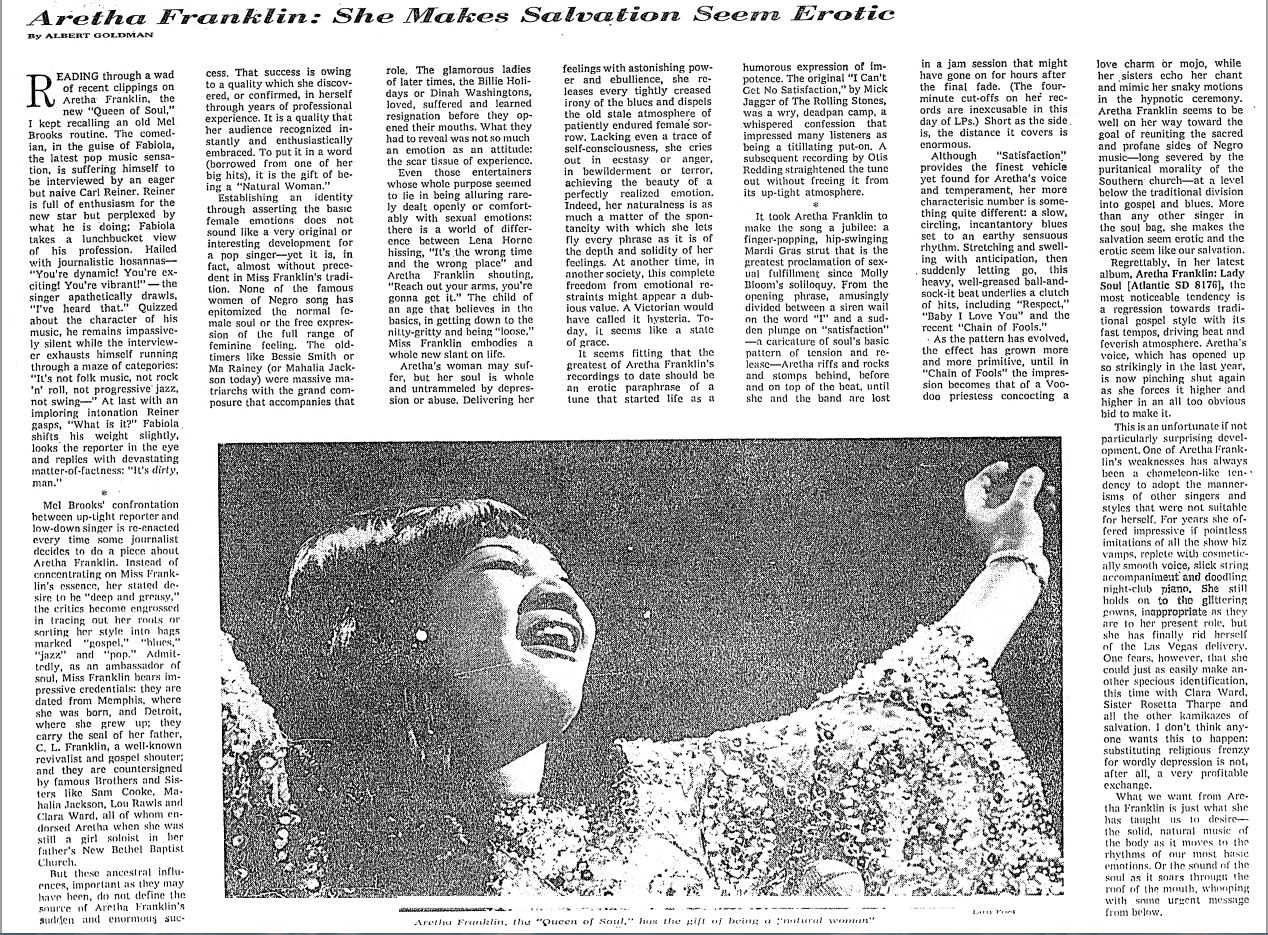Aretha Franklin is iconic. Known for her unbelievable talent as an American soul singer and songwriter from a young age, she is one of the few artists known by most generations of today’s Americans. Whether you grew up listening to Aretha as she poured out her soulful records, or just now get to appreciate her recent performances or recordings with Tony Bennett, you’ve most likely heard about or listened to this amazing performer. Her prowess as a performer catapulted her center stage, making her a symbol for the women’s and African-American movement through songs such as “Respect” among others.
However, she was not always respected as her famous song demanded, and this clipping from the New York Times in 1968 shows a more accurate real-time reaction to this rising star.
Albert Goldman, authoring this article, was no stranger to music critique and analysis. Writing epic-length books and articles about legends like Elvis and John Lennon, he commonly inspired outrage from his subject’s fans for his vulgar portrayal which saw no bounds. It seems that this article somewhat slipped under the radar, though, because the underlying themes he discussed were and are nothing new to American society. Trying to pinpoint what exactly provided the “it” factor for Aretha, what set her apart from the rest of the performers, we can already see his conclusion by looking at the title of the article. He credits her success to “the gift of being a ‘natural woman.'” He explains this as an embodiment of the full range of female emotion. Praising her ebullience and lack of self-consciousness as she sings each phrase effortlessly, he touches on the authenticity of her performance. Using her performance of Mick Jagger’s “I Can’t Get No Satisfaction” as an example of what he thinks is her greatest recording to date, he dives in on the sexualization of Aretha Franklin.
He calls the song “A jubilee: a finger-popping, hip-swinging Mardi Gras strut that is the greatest proclamation of sexual fulfillment since Molly Bloom’s Soliloquy. You can watch her performance and decide for yourself whether this is an accurate description.
Goldman compares her performance to that of the original Mick Jagger and The Rolling Stones, calling their take a “wry, deadpan camp, a whispered confession that impressed many listeners as a titillating put-on.” The sexuality is taken down a few notches here, and I’m uncertain his review is accurate. After all, I wouldn’t describe their 1969 performance as a “deadpan camp.”
http://youtu.be/XfCu_sbD508?t=1m19s
So why is this all important? The answer lies in the fact that this was not a one-time occurrence. It’s nothing new, it has happened before, and still happens today in our pop culture. The black female body has been extremely sexualized, tracing back to Europeans’ first contact with African music dance. Dr. Thompson of St. Louis University wrote an article and dissertation on this topic, documenting the sexualization through music from the 1600’s to present day pop culture. She claimed that the European “writers transformed African dance performances into pornographic scenes for consumption and sexual enticement for a mainly white male audience.” This created a precedent for society’s view on African and African-American musical performers, stretching from traditional African dance to the new single by Beyoncé. The concept is nothing new, but that doesn’t make it right.


Great post, S! You’re absolutely right to draw attention to the intersection between music, gender politics, and the objectification of black bodies, and Goldman’s article is a great window into this huge topic. Did you notice how his language around Franklin’s performance evokes lots of racial connotations? Her performance is a “jubilee” (a term worth defining, because it has lots of interesting layers of meaning), a “Mardi Gras strut” (thus connecting Franklin to the Deep South and particularly the hybrid culture of New Orleans, which we think helped inspire blues and early jazz). I don’t know what Molly Bloom’s Soliloquoy is, but again, that’s probably worth clarifying.
One more point: it’s a little unfair to compare Aretha Franklin’s 1968 performance to a 2013 Rolling Stones performance. Could you post a 1968 Rolling Stones performance so we can see whether Mick Jagger’s strut at that time was indeed more sexual than Aretha Franklin’s? We have to consider the possibility that Mick Jagger’s performance has become *more* sexualized over time, influenced in part by critics like Goldman; we can’t know for sure unless we see “archival” footage of some of his original performances.
Finally, can you link to Thompson’s article/dissertation in the main body of the blog post rather than copying and pasting it at the end? Thanks!